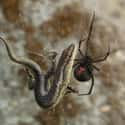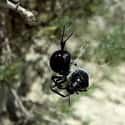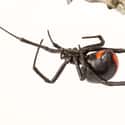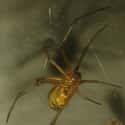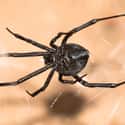-
(#10) Redback Spider
Species: Latrodectus hasseltii
Size: 3 - 10mm in length.
Location: The Redback Spider (also known as the Australian Black Widow) is believed to have originated in South Australia or near the Western Australian deserts. It is now found throughout Australia, Southeast Asia, and parts of New Zealand.
Distinguishing Features: Females are black in color and have a bright-red stripe on the upper side of the abdomen. The hourglass is present on the underside, and it can be colored either red or orange. Males are brown and black in color and are considerably smaller than females.
Why You Should Be Scared: The venom of the Redback Spider is dangerous to humans, and can result in significant pain at the bite site. It can also cause nausea, vomiting, headaches, and other serious issues that could require medical treatment and hospitalization. An antivenom for the Redback Spider has been available since 1956, and will counter the effects of a bite.
-
(#9) Latrodectus Lilianae
Species: Latrodectus lilianae
Size: 12 - 16mm in length.
Location: These spiders are found primarily in the steppes of the Iberian Peninsula, and don't often live near human activity.
Distinguishing Features: L. lilianae is black in color and features a small, white, and orange markings on its abdomen.
Why You Should Be Scared: They carry venom like other members of the genus, but due to their preference to be located in places where humans don't typically go, the full effects of its venom are not currently known, though they possess enough venom to potentially be lethal in rare cases.
-
(#7) Phinda Button Spider
Species: Latrodectus umbukwane
Size: Up to 31.9mm in length, making it the largest species of Widow spider.
Location: Phinda Button spiders can be found in the Phinda Private Game Reserve where they get their name, but also in the sand forest environments of Zululand, KwaZulu-Natal, South Africa.
Distinguishing Features: L. umbukwane is one of six species of the genus known as a button spider. They are black in color and feature red markings on the top and bottom of the abdomen. They are often surrounded by a thin outline, which is yellow or white in color. Males are smaller and are predominantly brown in color with cream-colored spots on their abdomens. The species was discovered in 2014 and described in 2019. The spiders are noteworthy due to their size, but also because their eggs are bright purple in color.
Why You Should Be Scared: Envenomization has not been fully studied as of 2020, but the toxicity of the Phinda Button spider's venom is similar to that of other species in the genus. Due to its size, it's probable that a bite would inject a larger amount of venom than others, but the full effects beyond probable pain are not fully understood.
-
(#3) Brown Widow
Species: Latrodectus geometricus
Size: 6 - 8mm in length.
Location: Though believed to originate in South Africa, the spider has been introduced in South America, Australia, Europe, North America, the Middle East, and many other places.
Distinguishing Features: Brown Widow spiders aren't black like their cousins, and instead have a mottling of brown and tan coloring on their bodies. The dorsal area has a longitudinal abdominal stripe, and three diagonal stripes on each flank. They do possess an hourglass marking, but it's orange in color, not red like others in the genus.
Why You Should Be Scared: The bites from a Brown Widow spider are often less toxic than those of the darker variety. This isn't due to the venom's toxicity, which is almost identical and is primarily due to the amount of venom injected in a bite. Their bites aren't as serious as other species, and will often result in a painful swollen red mark at the bite location. There have been reports of hospitalizations, but these are rarer than bites from other Widow spiders.
-
(#12) Black Button Spider
Species: Latrodectus renivulvatus
Size: 4 - 11mm in length.
Location: The Black Button spider is endemic to southern Africa, though it can be found in Saudi Arabia and Yemen.
Distinguishing Features: Their bodies and legs are primarily black, but their abdomen can contain red stripes that wrap around in a unique pattern. There is no hourglass pattern on the underside.
Why You Should Be Scared: A bite from a Black Button spider will often cause painful burning at the bite location, which is especially prevalent in the extremities. Severe reactions are possible and can require medical attention. An antivenom is available but should be administered as soon as possible due to the venom's lasting effects, which can carry on for up to a week.
-
(#6) Katipō
Species: Latrodectus katipo
Size: Up to 8mm in length.
Location: Katipō are found only in New Zealand, where they exist as the only native venomous spider. They are listed as being in "Serious Decline," and are threatened with extinction.
Distinguishing Features: Katipō are black in color, though they feature a distinctive stripe on their backs, which can be red, yellow, or cream-colored. The markings are present only on the females. The males are all white with black stripes and diamond-shaped markings.
Why You Should Be Scared: Bites from Katipō are rare, but they can lead to latrodectism, which typically produces a painful, red area in the location of the bite. More serious envenomations can result in hypertension, seizure, or even coma. No deaths have been reported since 1901, though they can occur in children.
New Random Displays Display All By Ranking
About This Tool
Spiders are a kind of animal that is not to be underestimated. These small reptiles with a length of up to 30 centimeters can be found in every corner of the earth, guarding their territory fearlessly. With eight long legs and excellent eyesight, spiders are excellent predators, and they can always eat fresh prey. Widow spiders are poisonous and become one of the deadly spiders known in the world.
In recent years, with the expansion of the scope of human life, reports of humans and animals being bitten and killed by widow spiders are frequent all over the world. The random tool will help to know 12 fascinating facts about the most terrifying spiders.
Our data comes from Ranker, If you want to participate in the ranking of items displayed on this page, please click here.











